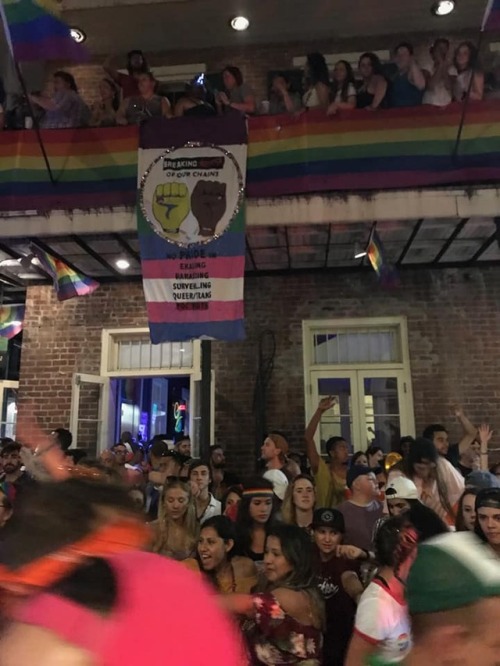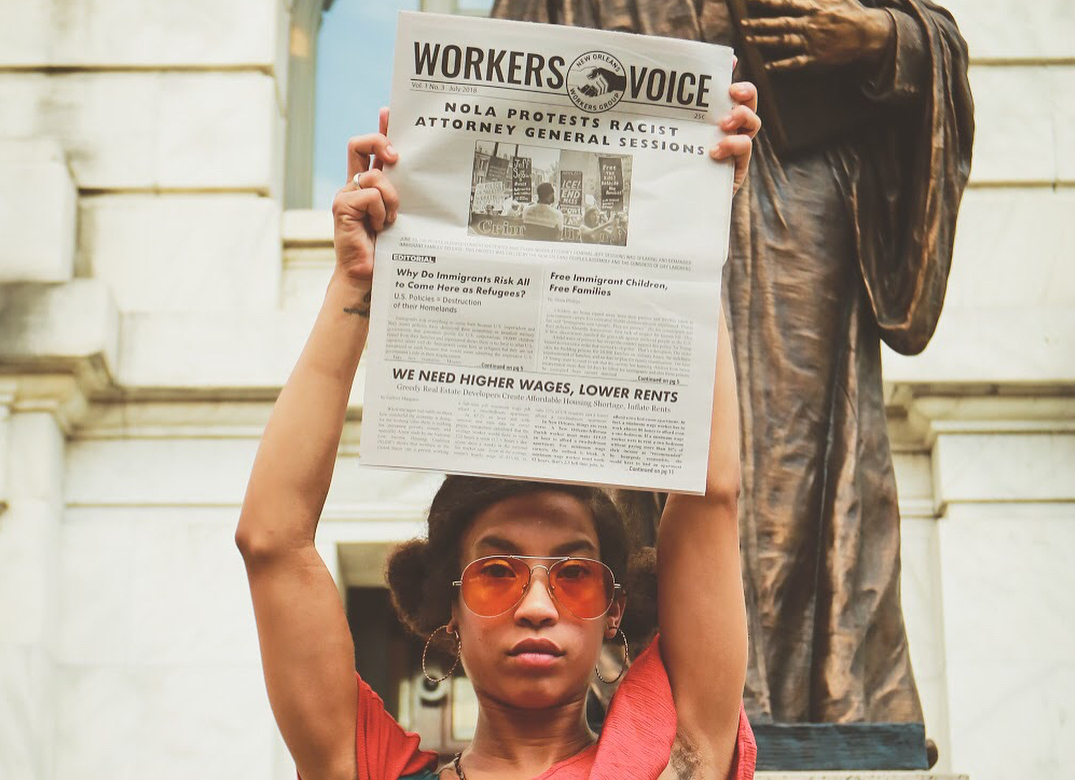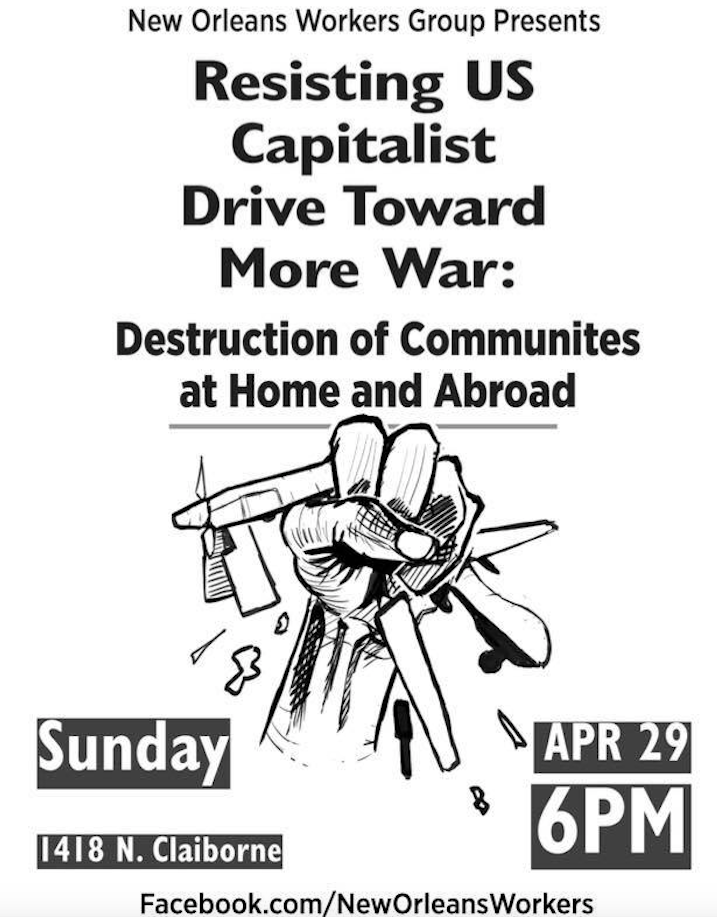
Contact: queerworkersnola@gmail.com and join the fight.



Workers and oppressed peoples of the world unite!

Contact: queerworkersnola@gmail.com and join the fight.




By Gavrielle Gemma
In New Orleans, tourists can hop between fancy restaurants, concerts, conventions and giant drinks in the French Quarter. Rarely do they ever see that women here and throughout the state are suffering.
According to a report on the “Status of Women in the States” issued by Institute for Women’s Policy Research, Louisiana’s score for employment & earnings and health & well-being was ‘F’. Poverty, reproductive rights and elected representation earned ‘D-‘.
Black women earn only 49% of white men’s earnings. It’s 68% for white women and 52% for Latinas. Black women are only 28% of managerial or professional jobs, yet have the highest percentage of women working.
Infant mortality and women’s mortality rate during childbirth are about the worst in the country. Louisiana ranks 49 out of 50 states for women’s health and well-being and 46th for reproductive rights.
Neither the state nor New Orleans has any laws giving workers paid sick leave or vacation. Most women have no pensions. Only one women was elected to a state executive office and women had no seats in Congress.
The good news is that women in unions earn $252 a week more than those who have no union.
Women in the city and state have potential power that has not yet been organized or exerted. We make up a large percentage of the work force and the bosses make billions in profits from our labor. We will soon make our power known.
[pdf-embedder url=”http://nolaworkers.org/wp-content/uploads/2018/02/FlyerForForum.pdf”]
By Leon Waters
“Bourgeois democracy, although a great historical advance in comparison with medievalism, always remains, and under capitalism is bound to remain, restricted, truncated, false and hypocritical, a paradise for the rich and a snare and deception for the exploited, for the poor.”
– V. I. LENIN, THE PROLETARIAN REVOLUTION AND THE RENEGADE KAUTSKY
Following the counter-revolutionary overthrow of the Louisiana Black Reconstruction government and its white radical allies (1870-1890’s), the former oppressor class was brought back to power; to political power, which is state power. The restoration of the oppressor class, which could no longer maintain chattel slavery, could now, in alliance with the former Northern adversary, jointly move forward in rebuilding Louisiana with ‘free labor’ or ‘wage labor’. The former Northern ally, the Republican Party, with its growing millionaire industrial class, would now betray the newly freed African people and conciliate to the new form of political rule, or state rule: Jim Crow. With its vicious ideology of white supremacy, the erection and proliferation of white chauvinist, white supremacist monuments, statues, markers, tombstones, fleur de lis, and other racist symbols would rise. These symbols represent the restoration of white supremacy rule, or the white supremacist dictatorship of the rich over the laboring masses, especially the Black masses who suffer from a double burden of oppression.
Like the whole United States, New Orleans society is divided into classes: the class of the rich millionaires and billionaires and the class of the poor workers, unemployed and incarcerated. The rich live a fine luxury life by paying low wages, piecemeal wages, poverty wages or, in some cases, no wages to the thousands of laboring masses. In order to maintain their system of thievery, the rich exercise their rule through control of the state and control of the state machinery-an organ of force, an organ of coercive rule, unrestricted by any law. The Tom Bensons, Marriotts, Entergy, etc. call this form of rule ‘democracy’.
The media flunkeys of the rich, i.e., the Times Picayune, WDSU television, Essence magazine, and all the intellectual flunkeys of the rich, Harvard, Tulane, LSU, etc. insist that our ‘democracy’ is the greatest expression of liberty, equality and freedom in the world.
The struggle to establish the democracy of the people, for the people and by the people, socialism, is really a struggle to establish a democracy of the majority, a struggle that must be waged to defeat the sham democracy of the rich, the democracy of the numerical few. What would Genuine Democracy look like? Once the class of millionaires and billionaires has been overthrown, once their resistance has been crushed, and once the bureaucratic machine of bourgeois state power has been smashed, the laboring masses can then erect a new state machinery to govern society. This new state, this new form of rule that represents the rule of the laboring people, will begin to reorganize a new economy by seizing the means of production, (factories, docks, hotels,) and capital (banks, financial institutions) and transforming them into the public property of the state, and hence, the laboring masses. These steps will end the exploitation of the laboring masses because the rich will no longer have control and a new economy can be organized and planned based on the needs of the laboring masses. The masses can then be drawn into the administration of the whole new state, trained and educated in the management of their new state power.
The New Orleans City Council would cease to be a ‘talking body’ and actually become a ‘working body’ for the genuine benefit of the laboring masses.
Institutions, including the schools, legislative bodies, courts, jails, and all other governing bodies would be converted into institutions of the laboring masses that suppress the rule of the rich millionaires and billionaires and their lackeys. The laboring masses would, obviously, establish a new legal framework, a new constitution that outlaws exploitation, all forms of oppression, including all forms and symbols of white supremacy.
New monuments, statues, markers, etc. that reflect the victory of the formerly oppressed over the oppressors would be erected widely to replace the current shameful reactionary monuments and street names today. The fight for democracy, true democracy, real democracy for the majority is part of the fight to defeat the rule of the rich today. Let us learn the lessons from the past. When George Washington and company got rid of English domination in 1783, they rightly made a clean sweep of all symbols of British oppression. They knew that if such symbols remained, the hand of reaction would be strengthened and oppression would not be eliminated. They tore down all statues of King George. The same should be done today!
FOR GENUINE DEMOCRACY!
SELF-DETERMINATION FOR THE AFRICAN AMERICAN NATION!
DOWN WITH WHITE SUPREMACY!
Leon A. Waters is a well known Black history expert. Born and raised in New Orleans, he has been a shipyard worker, a steel worker, a chemical worker, a custodian, a postal worker, a textile worker, a delivery man and a salesman during his life.